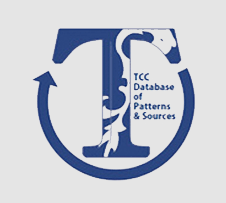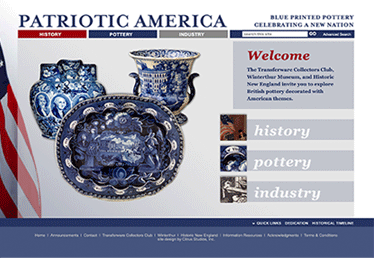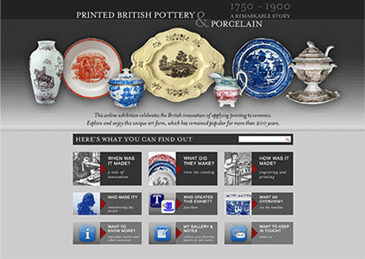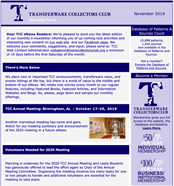


18,690 patterns and 1,139 sources and still growing.
Each month we feature a new pattern from our Pattern and Source Print Database and archive them on these pages.
Members only: for more information about these patterns and to see other similar patterns, search the Pattern and Source Print Database.
(Click on thumbnails to see larger images)
Known as "The Bewick Stag", this 9.5 inch pearlware plate is printed in underglaze blue by Minton. A General History of Quadrupeds (1790) by Thomas Bewick (1753-1828) pictures the Stag or Red Deer. He stands at the center of this earthenware dinner plate. Behind him are two smaller stags and, perhaps, a female deer. The border consists of vignettes which Bewick used on the his title pages or at the end of his descriptions of animals. Two have been identified. One is called "A Crouching Leopard Ready to Spring" c. 1792, which appears in the third edition of Quadrupeds, p. 92. The other is "Dogs Disputing", which appears in the 1826 edition of Bewick's Water Birds, p. 414. The other vignettes may also be by Bewick or by one of his apprentices. The "Crouching Leopard" vignette was used as the central pattern by other makers.
Shown is a 9.5 inch plate made by Pinder, Bourne & Co. (1862-1882). The Registry diamond indicates a date of May 29, 1879. The striking blue transfer vase and the Chrysanthemums are the only parts of the pattern that are transferred. The textured gold background and the table have been hand painted. This is also true of the image of the man holding a jug in the vase medallion. The pattern has a TCC assigned name.
Char Dish markSeen is a 9.25 inch dish made by Spode (1770-1833) in the early part of the 19th century. The dish was probably intended for serving potted char. The Arctic or sub-Arctic char is both a fresh water and salt water fish. It is similar to trout or salmon, and is found in very cold lakes and coastal waters.
Shown here on a 6.31 inch child's plate are hands illustrating the sign language alphabet consonants in two circles surrounding a single hand showing the vowels. Children's patterns were often used as teaching tools, and this one would be as useful today as it was in the 19th century. However, the alphabet is an example of the British manual alphabet which uses two hands rather than the American manual alphabet which uses one hand.
Children's patterns were often given as rewards for good behavior, christening presents and teaching tools. Children, in general, like animals, so this 5.75 inch plate with an exotic animal would have been a delightful gift.
Shown is a 13 by 10 inch platter in the “Clyde Scenery” series by John & Job Jackson (1831-1835). The pattern here is “Blythswood House.” In addition to purple, the pattern was printed in blue, black, brown, pink, green and two color. The TCC Database of Patterns and Sources shows 23 patterns in this series.
Shown is an earthenware 8 inch plate in the pattern known as "Dagger Border Class V." It was made by Wood & Caldwell (1790-1818), and is based on a Chinese hand-painted porcelain original.
Left: Wood & Caldwell 8 inch plate in the Dagger Border Class V pattern.
Right: The hand-painted Chinese Export hand-painted pattern, which is the source of the Dagger Border pattern.
Shown is a 4 inch planter in a British Themes Commemorative pattern titled “Entrance to the Liverpool & Manchester Railway.” The maker is unknown. This is a view of the famed Moorish Arch at Edge Hill in Liverpool, built in 1829 as part of the Liverpool & Manchester Railway which opened in 1830. It was the first railway line to carry passengers. The first photo shows the arch, and the second photo shows the train.
Shown is a dinner plate of unknown size made by Pountney & Allies (1816-1835), ca, 1835. The center shows advertising for the Free Masons Tavern & City Coffee House on Bridge Street along with the border commonly used by Pountney & Allies for their “Sicilian” pattern. This establishment was in business on Bridge Street in Bristol from around 1820 until 1866.
"Harvard College" by Enoch Wood & Sons (1818-1846).This 10.5 inch plate is printed in dark brown, and is from Wood's Celtic China series, probably circa 1835-1846. David and Linda Arman in Historical Staffordshire, An Illustrated Check-List (1974) list 18 views in this series. The series, printed in black, brown, purple, light blue, pink and green, portrays scenic views of historical America.
Seen here is a 2.35 inch tall and 2.5 inch wide child's (note the cartoon-like eagle) yellow glazed mug which appears to be a commemorative piece. Thomas Jefferson (April 13, 1743 - July 4, 1826) was the third President of the United States (1801-1809) and the principal author of the Declaration of Independence. This pattern belongs in the American Themes category.
Seen is pattern no. 63 in the series known as the Kennard Birds and Fish Series. The mark includes the name of the artist, Edward Kennard (1842-1910), as well as the manufacturer, T.C. Brown-Westhead, Moore & Co. (1862-1902), and the retailer, John Mortlock. The pattern is part of a dinner service of 100 pieces decorated with birds, fish and other animals in a natural setting.
Shown is an English advertising pot lid, 2.75 inches in diameter. The advertising promises a lot of things! The text reads: "Marisanta / A Curative Salve / Draws and Heals / Cuts, Scalds, Burns, Festers / Gatherings, Boils, Whitlows, Chilblains / For All Wounds / Amicus Humani Generis.” The Latin phrase translates: “Friend of the Human Race.” This pattern is part of the Advertising Category of the TCC Database of Patterns and Sources.
Philadelphia Waterworks print"The Dam And Water Works Philadelphia" is one of two patterns on a 10 inch plate depicting this view. However, each view has a different boat in the foreground. This pattern is known as "Stern Wheel" boat view, as opposed to the "Side Wheel" version. The backgrounds of the Water Works are the same on each. The source of this view is a drawing by Thomas Birch, engraved by R. Campbell, 1824. The pattern was made by Henshall & Co. (1790-1828).
Rich with content for ceramic collectors, researchers, authors, curators, and historic archaeologists, the sites are sure to deliver value for their visitors. The exhibition’s curators continue to enhance them and, now, with site application upgrades, including a new magnification feature and upgraded content management capabilities, the TCC and its collaborators are pleased to relaunch these exhibits, all free to a worldwide audience.

Branded Patriotic America, debuted in 2014 in collaboration with Historic New England, and the Winterthur Museum

Launched in 2015 in partnership with the Northern Ceramic Society.
 Not a member but want to receive email updates?
Not a member but want to receive email updates?